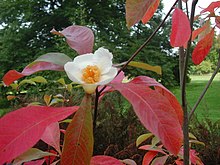Franklinia
| Franklinia | |
|---|---|
 |
|
| Flower and leaves in autumn | |
| Scientific classification | |
| Kingdom: | Plantae |
| (unranked): | Angiosperms |
| (unranked): | Eudicots |
| (unranked): | Asterids |
| Order: | Ericales |
| Family: | Theaceae |
| Genus: |
Franklinia W.Bartram ex Marshall |
| Species: | F. alatamaha |
| Binomial name | |
|
Franklinia alatamaha W.Bartram ex Marshall |
|
 |
|
| Natural range | |
| Synonyms | |
Franklinia is a monotypic genus in the tea plant family, Theaceae. The sole species in this genus is a flowering tree, Franklinia alatamaha, commonly called the Franklin tree, and native to the Altamaha River valley in Georgia in the southeastern United States. It has been extinct in the wild since the early 19th century, but survives as a cultivated ornamental tree.
In the past, some botanists have included Franklinia within the related genus Gordonia. The southeastern North American species Gordonia lasianthus differs in having evergreen foliage, flowers with longer stems, winged seeds, and conical seed capsules. (Franklinia was often known as Gordonia pubescens until the middle of the 20th century.)
Franklinia is now thought to be closer in relation to the Asian genus Schima. Recent DNA studies and examinations of floral ontogeny in the Theaceae place Franklinia together with Gordonia and Schima in a subtribe.Hybrid crosses have been produced between Franklinia alatamaha and Gordonia lasianthus, and between Franklinia alatamaha and Schima argentea.
Franklinia alatamaha is a deciduous large shrub or small tree growing to 10 m (33 ft) tall, but commonly 4.5–7.5 m (15–25 ft). It is commercially available for garden cultivation. It is prized for its lightly fragrant white flowers, similar to single white Camellia blossoms; the smell may remind some of orange blossoms or honeysuckle. The tree has a symmetrical, somewhat pyramidal shape, often with different individuals of the species forming almost identical crowns. It frequently suckers and can form several vertical trunks close to ground level. The bark is gray with vertical white striations and has a ridged texture. The alternate, obovate leaves are up to 6 in (15 cm) in length and turn a bright orange-red in the fall. Although difficult to transplant, once established, F. alatamaha can live a century or more.
...
Wikipedia

